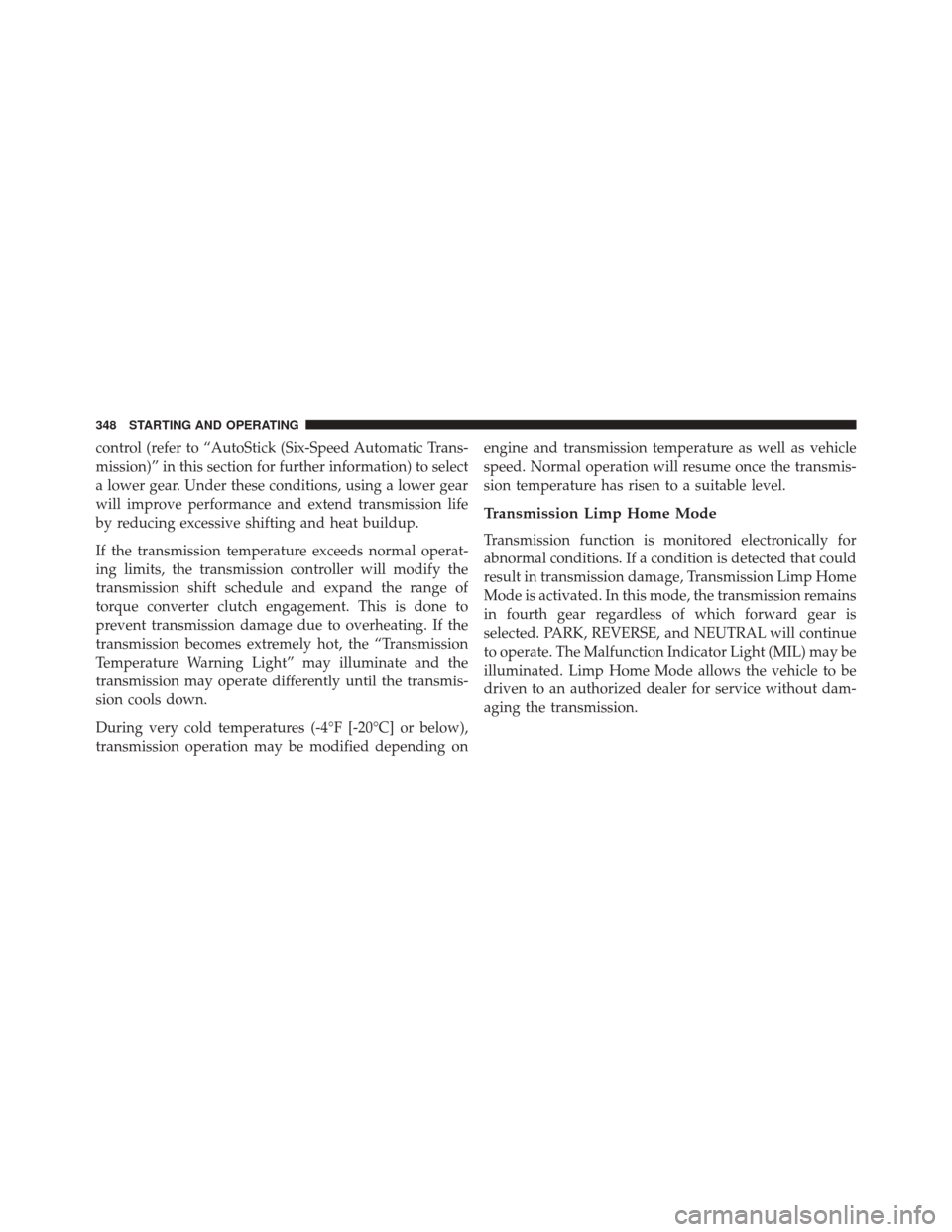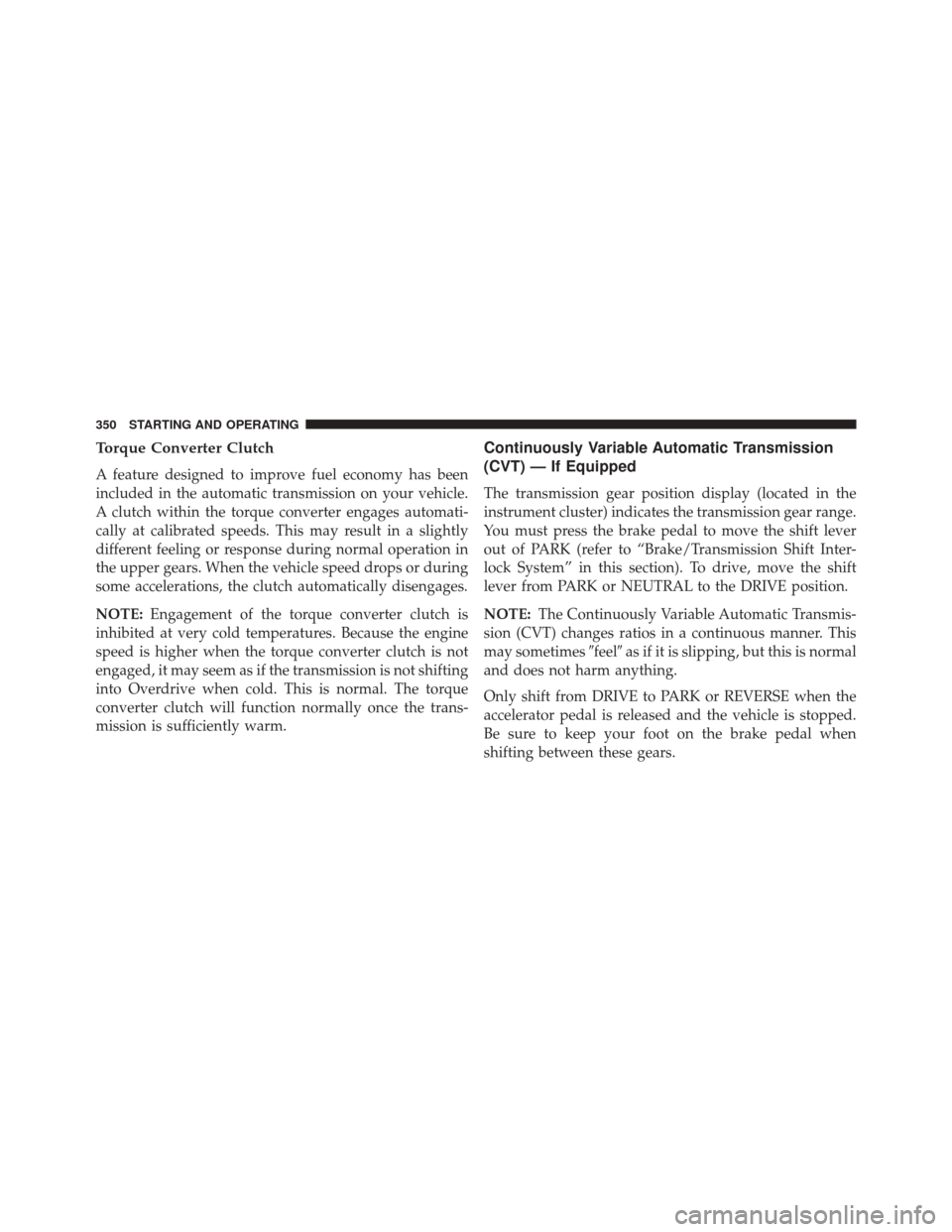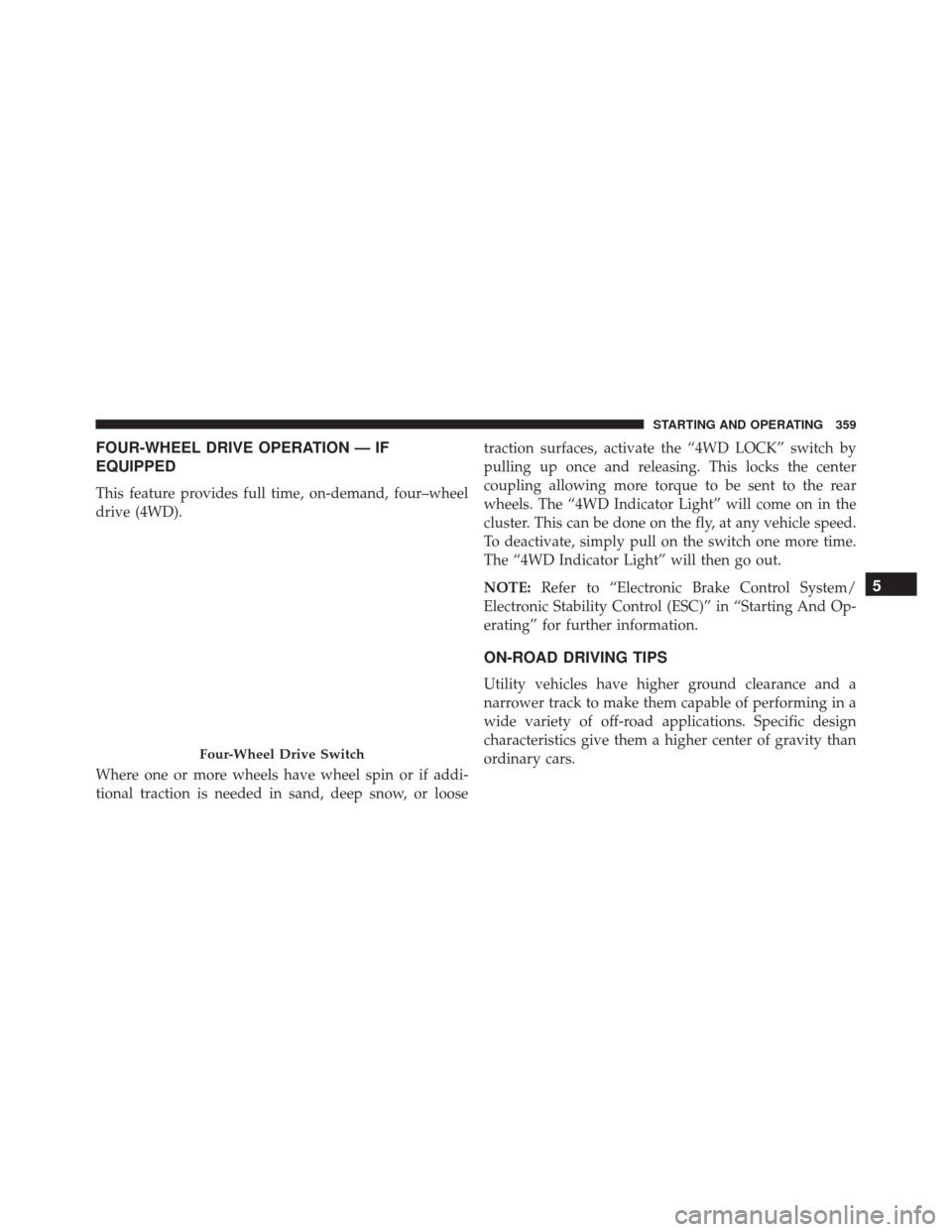Page 334 of 587

�AUTOSTICK ......................... .355
▫ AutoStick (Six-Speed Automatic
Transmission) ....................... .355
▫ AutoStick (CVT) — If Equipped ...........357
� FOUR-WHEEL DRIVE OPERATION — IF
EQUIPPED .......................... .359
� ON-ROAD DRIVING TIPS ................359
� OFF-ROAD DRIVING TIPS ...............360
▫ When To Use Low (L Off-Road) With The 4WD
Lock Lever Engaged — If Equipped ........361
▫ Driving In Snow, Mud And Sand ..........361
▫ Hill Climbing ....................... .363
▫ Driving Through Water .................365
▫ After Driving Off-Road .................367 �
POWER STEERING .....................368
▫ Power Steering Fluid Check ..............369
� PARKING BRAKE ..................... .370
� BRAKE SYSTEM ...................... .373
� ELECTRONIC BRAKE CONTROL SYSTEM . . . .374
▫ Electronic Brake Force Distribution (EBD) . . . .374
▫ Brake System Warning Light ..............374
▫ Anti-Lock Brake System (ABS) ............374
▫ Anti-Lock Brake Warning Light ............376
▫ Brake Assist System (BAS) ...............377
▫ Hill Start Assist (HSA) .................377
▫ Traction Control System (TCS) ............380
▫ Electronic Stability Control (ESC) ..........381
332 STARTING AND OPERATING
Page 340 of 587
ENGINE BLOCK HEATER — IF EQUIPPED
The engine block heater warms the engine, and permits
quicker starts in cold weather. Connect the cord to a
standard 110-115 Volt AC electrical outlet with a
grounded, three-wire extension cord.
The engine block heater must be plugged in at least one
hour to have an adequate warming effect on the engine.
WARNING!
Remember to disconnect the engine block heater
cord before driving. Damage to the 110-115 Volt
electrical cord could cause electrocution.
MANUAL TRANSMISSION — IF EQUIPPED
Five-Speed Manual Transmission
WARNING!
You or others could be injured if you leave the
vehicle unattended without having the parking
brake fully applied. The parking brake should al-
ways be applied when the driver is not in the vehicle,
especially on an incline.
Fully press the clutch pedal before you shift gears. As you
release the clutch pedal, lightly press the accelerator
pedal.
338 STARTING AND OPERATING
Page 341 of 587

Use each gear in numerical order, do not skip a gear. Be
sure the transmission is in first gear, (not third), when
starting from a standing position. Damage to the clutch
can result from starting in a gear higher than first gear.
CAUTION!
•Launching in any gear except 1st gear will result in
excessive slipping of the clutch and potentially
lugging or stalling the engine.
• Use each gear in numerical order, do not skip a
gear. Be sure the transmission is in first gear, (not
third), when starting from a standing position.
Damage to the clutch can result from starting in a
gear higher than first gear.
For most city driving, you will find it easier to use only
the lower gears. For steady highway driving with light
accelerations, fifth gear is recommended.
Never drive with your foot resting on the clutch pedal,
and never try to hold the vehicle on a hill with the clutch
pedal partially engaged. This will cause abnormal wear
on the clutch.
Shift Pattern
5
STARTING AND OPERATING 339
Page 342 of 587
Never shift into REVERSE until the vehicle has come to a
complete stop.
NOTE:During cold weather, until the transmission lu-
bricant is warm, you may experience slightly higher shift
efforts. This is normal and not harmful to the transmis-
sion.Recommended Shift Speeds
To use your manual transmission for optimal fuel
economy, it should be upshifted as listed in the following
table.
Manual Transmission Recommended Shift Speeds
Units in mph (km/h)
Engine Size Acceleration Rate1to2
2to33to4 4to5
All Engines Accel 14 (23)23 (37)29 (47) 45 (72)
Cruise 12 (19) 18 (29)25 (40) 32 (52)
340 STARTING AND OPERATING
Page 350 of 587

control (refer to “AutoStick (Six-Speed Automatic Trans-
mission)” in this section for further information) to select
a lower gear. Under these conditions, using a lower gear
will improve performance and extend transmission life
by reducing excessive shifting and heat buildup.
If the transmission temperature exceeds normal operat-
ing limits, the transmission controller will modify the
transmission shift schedule and expand the range of
torque converter clutch engagement. This is done to
prevent transmission damage due to overheating. If the
transmission becomes extremely hot, the “Transmission
Temperature Warning Light” may illuminate and the
transmission may operate differently until the transmis-
sion cools down.
During very cold temperatures (-4°F [-20°C] or below),
transmission operation may be modified depending onengine and transmission temperature as well as vehicle
speed. Normal operation will resume once the transmis-
sion temperature has risen to a suitable level.
Transmission Limp Home Mode
Transmission function is monitored electronically for
abnormal conditions. If a condition is detected that could
result in transmission damage, Transmission Limp Home
Mode is activated. In this mode, the transmission remains
in fourth gear regardless of which forward gear is
selected. PARK, REVERSE, and NEUTRAL will continue
to operate. The Malfunction Indicator Light (MIL) may be
illuminated. Limp Home Mode allows the vehicle to be
driven to an authorized dealer for service without dam-
aging the transmission.
348 STARTING AND OPERATING
Page 352 of 587

Torque Converter Clutch
A feature designed to improve fuel economy has been
included in the automatic transmission on your vehicle.
A clutch within the torque converter engages automati-
cally at calibrated speeds. This may result in a slightly
different feeling or response during normal operation in
the upper gears. When the vehicle speed drops or during
some accelerations, the clutch automatically disengages.
NOTE:Engagement of the torque converter clutch is
inhibited at very cold temperatures. Because the engine
speed is higher when the torque converter clutch is not
engaged, it may seem as if the transmission is not shifting
into Overdrive when cold. This is normal. The torque
converter clutch will function normally once the trans-
mission is sufficiently warm.
Continuously Variable Automatic Transmission
(CVT) — If Equipped
The transmission gear position display (located in the
instrument cluster) indicates the transmission gear range.
You must press the brake pedal to move the shift lever
out of PARK (refer to “Brake/Transmission Shift Inter-
lock System” in this section). To drive, move the shift
lever from PARK or NEUTRAL to the DRIVE position.
NOTE: The Continuously Variable Automatic Transmis-
sion (CVT) changes ratios in a continuous manner. This
may sometimes �feel�as if it is slipping, but this is normal
and does not harm anything.
Only shift from DRIVE to PARK or REVERSE when the
accelerator pedal is released and the vehicle is stopped.
Be sure to keep your foot on the brake pedal when
shifting between these gears.
350 STARTING AND OPERATING
Page 357 of 587

further information) to select a lower gear ratio. Under
these conditions, using a lower gear ratio will improve
performance and extend transmission life by reducing
excessive shifting and heat buildup.During sustained high speed driving or trailer
towing up long grades on hot days, the auto-
matic transmission oil may become too hot. If
this happens, the transmission overheat indica-
tor light will come on, and the vehicle will slow slightly
until the transmission cools down enough to allow a
return to the requested speed. This is done to prevent
transmission damage due to overheating. If the high
speed is maintained, the overheating may reoccur, as
before, in a cyclic fashion. LOW (L) — If Equipped
Use this range for engine braking when descending very
steep grades. In this range, the transmission will down-
shift for maximum engine braking, and upshifts will
occur only to prevent engine overspeed.
AUTOSTICK
AutoStick (Six-Speed Automatic Transmission)
AutoStick is a driver-interactive transmission feature
providing manual shift control, giving you more control
of the vehicle. AutoStick allows you to maximize engine
braking, eliminate undesirable upshifts and downshifts,
and improve overall vehicle performance. This system
can also provide you with more control during passing,
city driving, cold slippery conditions, mountain driving,
trailer towing, and many other situations.
5
STARTING AND OPERATING 355
Page 361 of 587

FOUR-WHEEL DRIVE OPERATION — IF
EQUIPPED
This feature provides full time, on-demand, four–wheel
drive (4WD).
Where one or more wheels have wheel spin or if addi-
tional traction is needed in sand, deep snow, or loosetraction surfaces, activate the “4WD LOCK” switch by
pulling up once and releasing. This locks the center
coupling allowing more torque to be sent to the rear
wheels. The “4WD Indicator Light” will come on in the
cluster. This can be done on the fly, at any vehicle speed.
To deactivate, simply pull on the switch one more time.
The “4WD Indicator Light” will then go out.
NOTE:
Refer to “Electronic Brake Control System/
Electronic Stability Control (ESC)” in “Starting And Op-
erating” for further information.
ON-ROAD DRIVING TIPS
Utility vehicles have higher ground clearance and a
narrower track to make them capable of performing in a
wide variety of off-road applications. Specific design
characteristics give them a higher center of gravity than
ordinary cars.
Four-Wheel Drive Switch
5
STARTING AND OPERATING 359